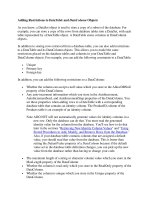Zoos and Animal Welfare Phần 4 ppt
Bạn đang xem bản rút gọn của tài liệu. Xem và tải ngay bản đầy đủ của tài liệu tại đây (466.25 KB, 12 trang )
Space Matters
A female elephant herd’s home range covers huge spaces through
which it moves to forage and browse for food, minerals, and water
and to seek social contact with related herds. Wild elephants walk
for miles everyday yet require only about four hours of sleep a day.
AZA mandates 75 square meters of indoor space and 252 square
meters of outside space for two elephants. In the wild, home ranges
of female African elephant herds, for example, vary from 15 to 50
square kilometers.
Let’s do the math: in the wild, a modest elephant home range
is 15 square kilometers or 15,000,000 square meters (1 square kilo-
meter equals 1,000,000 square meters). In comparison, AZA’s
acceptable barn space for two elephants is about 200,000 times
smaller than the space elephants would chose for themselves.
AZA’s outside yard space is about 60,000 times smaller than the
smallest known elephant home range.
Not surprisingly, AZA elephants suffer from arthritis, foot rot,
and other orthopedic disabilities that often contribute to their
early deaths.
The Sanctuary is not another kind of zoo. We exist to provide
a nurturing, permanent home for elephants already caught up in
the web of captivity. Breeding our elephants to produce young
that will, in turn, face a lifetime in captivity with no hope of return
to the wild has no place in the Sanctuary.
AZA Accreditation Is No Guarantor of Elephant
Well-Being
AZA’s standards do not recognize or protect the lifelong bond
between elephant mothers and their female offspring, nor do they
acknowledge or protect relationships that AZA’s unrelated adult
female elephants have forged among themselves in their urgent
quest for satisfying social affiliation.
AZA’s standards permit elephants to be chained in their barns
for up to 12 hours every day, year round. The Sanctuary does not
permit chaining.
AZA’s standards allow keepers to hit elephants as “training.” The
Sanctuary believes that hitting an elephant is never justifiable.
36 Zoos and Animal Welfare
Zoos_ITCY_v5.qxd 11/5/07 5:31 PM Page 36
Elephants at the Sanctuary receive superior veterinary care from
professionals whose experience and credentials meet or exceed
AZA’s standards. The Sanctuary, like AZA zoos, has written emer-
gency protocols addressing safety and veterinary emergencies.
Safety for Animals and People
Since 1990, AZA has reported that elephants in their accredited
institutions have seriously injured 27 keepers, 5 of them fatally.
Elephants Are Better Off in Sanctuaries 37
Percentage of U.S. Zoos Facing Cutbacks
Zoos_ITCY_v5.qxd 11/5/07 5:31 PM Page 37
The Sanctuary staff has never suffered a single serious injury or
fatality.
AZA standards discourage but do not prohibit elephant rides
and shows where the public comes into direct contact with the
animals. Sanctuary elephants never give rides, never put on shows,
and are never exposed to direct contact with visitors.
The Elephant Sanctuary supports research and conservation
efforts in Asia and permits noninvasive research at the Sanctuary.
The Elephant Sanctuary’s educational programs for children and
live online video are unparalleled.
Like many AZA zoos, the Sanctuary is a private not-for-profit
institution depending on charitable giving and grants for its pro-
gramming. . . .
The Sanctuary provides its elephants a permanent home in a
large, natural environment where they are free to build lives they
choose for themselves with the support of expert veterinarians,
experienced staff, and loyal Sanctuary members.
38 Zoos and Animal Welfare
Zoos_ITCY_v5.qxd 11/5/07 5:31 PM Page 38
Elephants do not necessarily enjoy a greater quality of life
in animal sanctuaries as opposed to zoos, argue Michael
Hutchins and William Conway, who work for the
Association of Zoos and Aquariums (AZA) Department of
Conservation and Science. While zoos are governed by strict
AZA regulations, animal sanctuaries must only comply with
the United States Department of Agriculture (USDA) stan-
dards, which are far less stringent. In addition, many sanc-
tuary elephants are not allowed to breed, which, according
to biologists, is important for social bonds. Finally, most ani-
mal sanctuaries have no long-term plans for income and
revenue, which jeopardizes their ability to provide a healthy
quality of life for their wards. Ultimately, despite the fact
that many animal sanctuaries provide more space, bigger
does not necessarily mean better.
A
ZA [Association of Zoos and Aquariums] institutions con-
stantly review the status of their animal collections and facil-
ities and it is every director’s prerogative to determine which ani-
mals are appropriate for their facility at any given time and which
are not. However, a common thread running through many of the
media reports and in quotes from animal activists is that elephants
39
Elephants Are Not
Necessarily Better Off
in Sanctuaries
Michael Hutchins and William Conway
SIX
Michael Hutchins and William Conway, “Zoo vs. Sanctuary,” AZA’s Communique, August 2004,
pp. 54-56. Copyright © 2004 Association of Zoos and Aquariums. All rights reserved. Reproduced
by permission.
Zoos_ITCY_v5.qxd 11/5/07 5:31 PM Page 39
would be “better off” living in these sanctuaries than in any AZA
accredited zoo. This implies that the quality of animal care at
these sanctuaries is better than it is at accredited zoos. It also
implies that, within their respective categories, sanctuaries and
zoos are all of similar quality. But is this really true? Absolutely
not! . . .
Bigger, Not Better
[Many] elephant sanctuaries . . . offer hundreds of acres of space
through which elephants can roam. In contrast, elephants at some
urban zoos are maintained in considerably smaller areas (one acre
or less) and therefore have little opportunity for exercise or social
benefits that come from larger group sizes. However, this is chang-
ing. While many AZA facilities cannot offer the same amount of
space as the two sanctuaries in question [in Hohenwald, TN, and
San Andreas, CA], they are still quite large and complex. There
are also many zoos that have new elephant facilities in the works,
some of which are multi-acre.
While space may be important for elephants, there are no sci-
entific studies that can assist us in determining either the mini-
mum or optimum amount of outdoor space required for captive
elephants. It is important to note, however, that bigger does not
always imply better. There are many other factors that must be
considered, including enclosure complexity and environmental
enrichment, group size and composition, training, safety, veteri-
nary care, nutrition, and so forth, when evaluating the quality of
any elephant management program.
Lack of Breeding
Elephant sanctuaries typically do not breed animals or transfer
them to other facilities for the purposes of genetic management.
Most animals going to sanctuaries are on a one-way trip and will
remain there for the rest of their lives. This is consistent with a
sanctuary’s sole focus on individual animal welfare.
In contrast, the focus of AZA and its members is both on the
welfare of individuals and the population as a whole, both in zoos
40 Zoos and Animal Welfare
Zoos_ITCY_v5.qxd 11/5/07 5:31 PM Page 40
and in nature. Participation in programs such as Species Survival
Programs (SSP) may involve moving animals from one facility to
another, either temporarily or permanently. In AZA zoos, ele-
phants are seen as animal ambassadors, which play an important
role in supporting conservation of their cousins in the wild. This
is accomplished through a wide variety of activities, including
public education, professional staff training, research, technolo-
gy development, field conservation and fundraising.
Cooperative programs also control breeding so that populations
do not overshoot their available space. Such programs are thus seen
as contributing to professional and humane animal management
Elephants Are Not Necessarily Better Off in Sanctuaries 41
A trainer trims the foot of an Asian elephant at a sanctuary in
Arkansas. Animal sanctuaries may not be better for animals due
to less-stringent guidelines about how the animals are cared for.
Zoos_ITCY_v5.qxd 11/5/07 5:31 PM Page 41
and care, not detracting from them. Indeed, some biologists have
argued that family life is critical to elephant social well-being. Births,
such as those that recently occurred at Disney’s Animal Kingdom
and the San Diego Wild Animal Park, are known to have a pro-
found effect on adult behavior, often further cementing female social
bonds. Sanctuary elephants that are not allowed to breed will never
have these opportunities, and this could be seen as diminishing
their “welfare.”
Standards of Accreditation
Although licensed by the United States Department of
Agriculture’s (USDA’s) Animal and Plant Inspection Service
(APHIS) and their state wildlife agencies, the elephant sanctu-
aries are not accredited by AZA. This means that they are not
required to meet AZA accreditation standards, which are consid-
erably more detailed and comprehensive than USDA standards.
In addition, AZA established detailed Standards for Elephant
Management and Care in 2001 and updated them in 2003. Non-
members are not required to meet these standards, nor are they
obligated to maintain them over time.
Of particular interest to AZA’s Accreditation Commission is
the long-term financial stability of a zoological institution. Without
a predictable and reliable source of income, it is difficult or impos-
sible for any organization to provide proper long-term care for ani-
mals or to ensure the safety of their staff. This is an especially
important consideration for long-lived and potentially dangerous
animals, such as elephants. Like sanctuaries, most AZA zoos are
non-profit entities, but still have solid business plans to ensure
that they are not solely dependent on unpredictable “soft money”
donations. It is my opinion that sanctuaries, which are nearly
totally dependent on soft money, should be required to submit pro
forma annual operating expenses and projected revenue for the
next 5–10 years before receiving any additional elephants.
The sanctuaries in question have their own accrediting body—
The Association of Sanctuaries (TAOS). However, a review of
the TAOS web site provided no information on the accreditation
42 Zoos and Animal Welfare
Zoos_ITCY_v5.qxd 11/5/07 5:31 PM Page 42
process or how long accreditation lasts. In addition, no informa-
tion was available on the specific standards to which each TAOS
member is to be measured against.
Do the sanctuaries in question meet AZA standards? The sim-
ple fact is that we do not know about the quality of animal care
at these facilities because they are not accredited. This brings up
a whole series of critical questions:
If additional elephants are added to the sanctuaries, will the
facilities have sufficient staff to manage all of the animals appro-
priately and safely?
Are the keepers well trained and knowledgeable about elephant
management? (AZA elephant program managers are required to
Percentage of Zoo Animals That Are
Removed from Their Homes Each Year
Zoos_ITCY_v5.qxd 11/5/07 5:31 PM Page 43
complete a certified Elephant Management course such as the one
offered by the AZA Schools for Zoo and Aquarium Professionals).
Is the veterinary staff experienced with elephants, or with treat-
ments of specific maladies that affect elephants, such as TB?
Are the care programs science-based? (e.g., one sanctuary’s vet-
erinary team includes an individual who prescribes “flower
essences” and claims to communicate telepathically with animals).
What kinds of on-site veterinary facilities are in place?
Are there procedures to deal with emergencies or natural or
human-caused disasters?
Can the elephants perform essential behaviors necessary for
proper management?
Is the facility financially stable now and into the future?
These are all examined in great detail during the AZA accred-
itation process, as they should be at any prospective elephant hold-
ing facility. Why are answers to these questions important? There
have been numerous cases where USDA licensed facilities, includ-
ing so-called “sanctuaries”, have degraded over time, on some
occasions necessitating removal of animals and/or closure of the
facility. Many animals have suffered as a result. . . .
Lingering Questions
Sanctuaries, like zoos, maintain animals in captivity, experience
the same challenges of day-to-day animal management and care,
need to engage in intensive fund-raising, and may support educa-
tion and conservation.
Space seems to be the key difference between the sanctuaries
in question and AZA-accredited zoos. How much space do cap-
tive elephants need for proper management? Unfortunately, there
is little scientific evidence to help guide us in such decisions.
Furthermore, it seems as if the media and public have seized on
this single factor in their comparisons of sanctuaries and zoos.
Chalk that up to good PR.
Zoos may find it difficult to compete with the perception of
animals roaming “freely” through hundred-acre enclosures.
However, I hope I made it clear that space is not the sole factor
44 Zoos and Animal Welfare
Zoos_ITCY_v5.qxd 11/5/07 5:31 PM Page 44
when evaluating the quality of an elephant management program.
The difference between having four or one hundred acres may
not be as critical to elephants as having social companionship,
effective environmental enrichment and quality nutrition and
veterinary care.
Until sanctuaries open themselves up for detailed peer-
evaluation through periodic accreditation there will be no way
to verify that their animal care programs, long-term financial
stability, staff numbers and expertise, facilities, safety procedures
and so forth meet professional standards. Nor will there be any
way to ensure that such standards will be maintained over time.
It may be desirable for AZA members to cooperate with quali-
fied sanctuaries. AZA has one accredited member sanctuary now
and there could be more in the future. Although many AZA zoos
maintain large numbers of geriatric animals and continue to pro-
vide them with quality care, it may be advantageous to have a place
to send such individuals to live out the remainder of their lives.
The real question is: which elephant sanctuaries meet profes-
sional standards of animal management and care? The quality of
care in non-AZA accredited facilities varies, sometimes widely.
It is not enough for individual facilities to pass USDA inspections
or to be “accredited” by TAOS, an organization that may be well
intentioned, but currently has no detailed standards or method
of enforcing them.
If the sanctuaries in question want to prove the quality and sta-
bility of their animal care programs, then I would encourage them
to apply for AZA accreditation. Currently, there is no higher stan-
dard of professional animal care and these standards can be expect-
ed to continually evolve over time. Alternatively, USDA APHIS
could adopt AZA’s standards for elephant management and care
and apply them to all elephant holding facilities as a condition of
licensing.
Elephants Are Not Necessarily Better Off in Sanctuaries 45
Zoos_ITCY_v5.qxd 11/5/07 5:31 PM Page 45
Most zoos have a dirty little secret called “surplus animals,”
according to People for the Ethical Treatment of Animals
(PETA). When zoo animals grow up and are no longer the
cute, crowd-pleasing attractions they once were, they
become a burden instead of a source of income for zoos. In
other words, they become surplus animals. Surplus animals
are frequently sold to canned hunting ranches, where
hunters pay for the privilege of killing them. Often they are
sold to other zoos of questionable quality, to live out the rest
of their lives in neglect. Other times, they are simply killed
by the zoo itself. According to PETA, surplus animals are a
huge problem for zoos, and the situation stands to get worse
before it can get better.
D
espite their professed concern for animals, zoos can more
accurately be described as “collections” of interesting “spec-
imens” than actual havens or simulated habitats (real homes).
Zoos teach people that it is acceptable to interfere with animals
and keep them locked up in captivity where they are bored,
cramped, lonely, deprived of all control over their lives, and far
from their natural homes.
46
People for the Ethical Treatment of Animals
SEVEN
Surplus Animals Are
a Big Problem
People for the Ethical Treatment of Animals, “Zoos: Pitiful Prisons,” www.peta.org, 2004.
Reproduced by permission.
Zoos_ITCY_v5.qxd 11/5/07 5:31 PM Page 46
Virginia McKenna, who starred in the classic movie Born Free
and received an Order of the British Empire in 2003 for her work
in behalf of captive animals, says that her participation in Born
Free made her realize that “wild animals belonged in the wild, not
imprisoned in zoos. . . . Freedom is a precious concept, and wild
animals suffer physically and mentally from the lack of freedom
captivity imposes.”
Cost-Cutting Hurts Animals
Zoos vary in size and quality—from drive-through parks to small
roadside menageries with concrete slabs and iron bars. Although
more than 135 million people visit zoos in the United States and
Canada every year, most zoos operate at a loss and must find ways
to cut costs or add gimmicks that will attract visitors. The Wall
Street Journal reported that “nearly half of the country’s zoos are
facing cutbacks this year . . . [a]ttendance, meanwhile, is down
about 3% nationwide.”
Ultimately, animals are the ones who pay the price. Precious
funds that should be used to provide more humane conditions for
animals are often squandered on cosmetic improvements, such as
landscaping or visitor centers, in order to draw visitors.
Animals suffer from more than neglect in some zoos. Rose-Tu,
an elephant at the Oregon Zoo, suffered “176 gashes and cuts”
inflicted by a zoo handler wielding a sharp metal rod. Another
elephant, Sissy, was beaten with an ax handle at the El Paso Zoo.
The animals on exhibit are not the only ones who suffer. Most
zoos have an area that the public never gets to see, where rabbits,
rats, mice, baby chicks, and other animals are raised and killed to
provide food for the animals on display. According to one zoo vol-
unteer, killing methods include neck-breaking and “bonking,” in
which zookeepers place “feed” animals in plastic bags and slam their
heads against a hard surface to induce fatal head injuries. . . .
Born Free, Sold Out
Zoos continue to capture animals from the wild to put them
on public display. In 2003, the San Diego Wild Animal Park
Surplus Animals Are a Big Problem 47
Zoos_ITCY_v5.qxd 11/5/07 5:31 PM Page 47









![[Nông Nghiệp] Kỹ Thuật Trồng Đậu Nành - Ks.Nguyễn Việt Thái phần 4 ppt](https://media.store123doc.com/images/document/2014_07/13/medium_tkv1405268425.jpg)